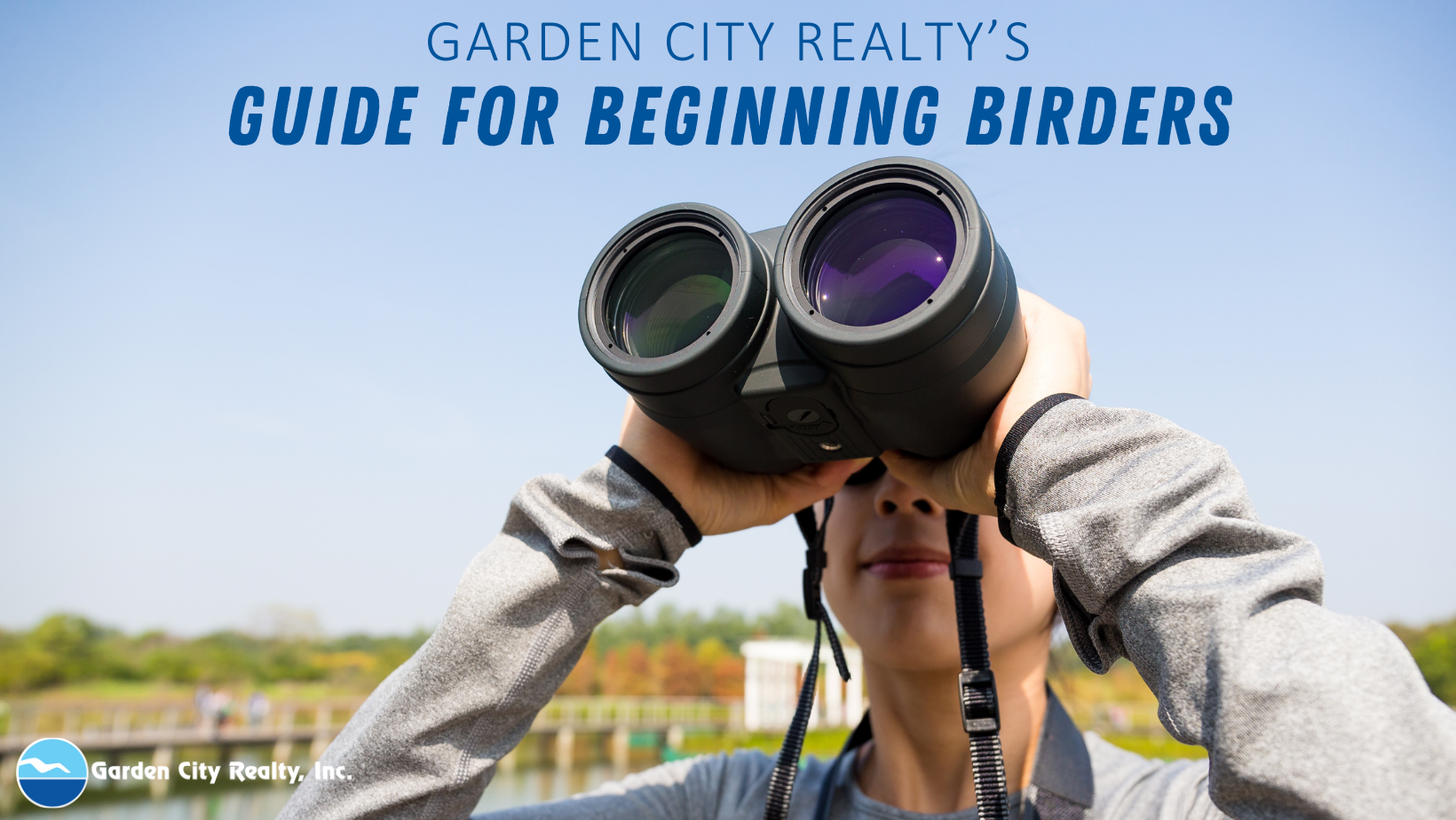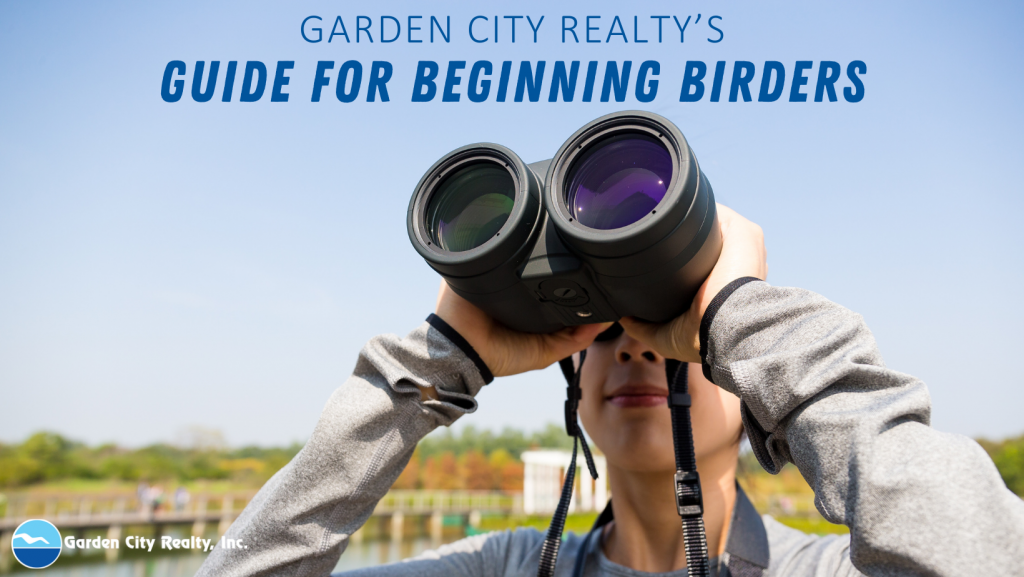Posts
GARDEN CITY REALTY’S GUIDE FOR BEGINNING BIRDERS


While dipping your toes in the Atlantic may not be ideal this time of year, there’s another outdoor winter activity you can partake in when you’re visiting along the South Strand that you might not have thought about.
Have you ever tried birdwatching – or simply “birding” as it’s called by those in the know?
You may not have expected it, but winter can be the best time to go birding.
In fact, one of the biggest local birding events happens annually between Christmas Day and New Year’s Day, and you won’t have to venture far from your Garden City Realty vacation rental property to participate. The annual Litchfield Beach-Pawleys Island Bird Count, hosted by the Waccamaw Audubon Society, is set for Dec. 30. It is one of more than 1,700 Christmas bird counts held nationally.
What in the spotted sandpiper is a bird count?
Hold onto your feathers, we’ll get to that – and a whole lot more.
If you’ve never been birding before but are interested in giving the pastime a try, we’ve compiled a beginner’s guide to get you started – and you honestly couldn’t have landed in a better spot as our slice of the Carolina coast is teeming with a variety of bird species that call our area home – or just like you, come to visit for awhile.
According to members of the Waccamaw Audubon Society, our area is fertile ground for winged wonders because we’re part of the Atlantic Flyway, which includes “some of the hemisphere’s most productive ecosystems, including forests, beaches and coastal wetlands. These diverse habitats in our area support a network of wildlife and abundant food sources for birds – and also attracts migrating birds.”
Is that why the traditional off-season is such a great time to go birding along the South Strand?
“Some birds we only see – or are more easily seen – in the winter, when they migrate south; especially waterfowl like ducks,” said Mike Walker, an interpretive ranger at Huntington Beach State Park, which offers birding programs and other birding resources. “The (park’s) jetty in winter is also a good spot to see relatives of the puffins, like razorbills and dovekies.”
Whoa there, Ranger Mike, remember, we’re new to this birding thing.
Not to worry, if you don’t know your puffins from your dovekies, Huntington Beach State Park and the Waccamaw Audubon Society have you covered, with a bird checklist that you can download here. It details more than 300 types of birds, whether they are common or rarely sighted here – and helps you keep track of the ones you’ve seen.
And of course, there’s also an app for that. Download the Merlin Bird ID app on your smartphone, and it can help you identify your feathered friends you see or hear. Go to https://merlin.allaboutbirds.org/
LEAVING THE NEST
What’s so engaging about spotting birds in their habitats and why has birding become increasingly popular?
“Spending time and energy finding and observing birds is great for your physical, mental, and emotional health,” writes Wild Latitudes Worldwide Nature Tours blogger Ivan Phillipsen. “You might even end up hiking to somewhat remote areas or at least walking for miles to find interesting birds. Some of the most rewarding birding experiences are those that you work the hardest for.”
You won’t have to work your wallet very hard because birding can be an inexpensive pursuit. One of the great things about birding is you don’t really need a bunch of gear to get started.
Of course, like any other pursuit, plenty of gadgets are employed by many birders – but the only things you really need are a sense of adventure, a healthy dose of curiosity, a desire to learn and mobility.
That being said, there is one bit of indispensable equipment. “The one piece of gear that is essential to any birder is binoculars,” said Dale Schofield, vice president of the Waccamaw Audubon Society. “The best for birding are 8 X 42.”
BestReviews.Guide rates the year’s best birding binoculars here.
Walker suggests beginning birders stop by the Nature Center at Huntington Beach State Park for more resources. “The Nature Center is a great resource for finding out the most current bird sightings in the park, as well as several displays about birds and birding,” he said.
Birding programs are also offered at the park, but those run only March through October.
As depicted in the Steve Martin-Jack Black-Owen Wilson movie “The Big Year,” birding can get competitive, but you’re not likely to experience any shade or hazing from experienced birders around here.
Veteran birders will be happy to show you the ropes.
“Go birding with experienced birders,” suggests Schofield. “They will spot birds and will tell you how to distinguish various species. Join your local Audubon Chapter and participate in meetings, bird walks and field trips.”
Be sure to adhere to COVID-19 protocols, of course.
To get a feel for what serious birding is like, we recommend viewing the aforementioned “The Big Year,” it’s family-friendly and available on Disney+. It chronicles three men’s obsessive quest to achieve a Big Year, which is a contest among birders to see who can identify by sight or sound the most bird species in a single calendar year within a specific geographic area.
While the film takes certain liberties with the activity of birding and with its depiction of birders, as most Hollywood movies do with any given subject, it has mostly been well-received by the birding community.
Ranger Walker is a fan of the flick. “Loved it,” he said. “We have actually shown it as an outdoor movie a couple of times at the park.”
Including “The Big Year,” Optics Mag has identified a slate of movies – dramas and documentaries – about birding that are worth watching. Check out their list: https://opticsmag.com/bird-documentaries-and-movies/
HOT SPOTS
You’ve got your binoculars, bird checklist, writing utensil, comfortable walking shoes and you’re ready to start your South Strand birding adventure.
But where do you go?
If you’re staying at a Garden City Realty oceanfront vacation rental, you can probably get started on your balcony or deck or with a leisurely stroll out on the beach.
However, to see the widest variety of species and to make the most of your time, we’ve identified a few of the area’s birding hot spots of the D-I-Y (do it yourself) variety.
Huntington Beach State Park, 16148 Ocean Highway, Murrells Inlet
Arguably the crown jewel of birding hotspots along the South Strand, more than 300 species of birds have been spotted on the park’s 25,000 acres.
How easy – or hard – is it for a beginner to start birding at Huntington?
“Easy!” exclaimed Walker. “The causeway a couple of hours on either side of low tide might contain almost every species of wading bird found in South Carolina. We also offer birding programs Wednesdays at 10 a.m. from March-October, meeting at the causeway parking lot.”
Why is Huntington a great place for birding?
“The variety of ecosystems – salt marsh, freshwater marsh, brackish marsh, maritime forest, sand dunes, beach, rocky coast (in the form of a man-made jetty) – in a relatively compact area,” said Walker.
For more details about birding at Huntington, go to: https://southcarolinaparks.com/huntington-beach/birding
Admission is $8 for adults, $5 for seniors, $4 for ages 6-15 and free 5 and younger.
The park is open 6 a.m. to 6 p.m. daily.
Myrtle Beach State Park, 4401 South Kings Highway, Myrtle Beach
Huntington’s sister property, located on the southern edge of Myrtle Beach and just to the north of Surfside Beach, ain’t too shabby when it comes to birding either.
“While you can see a few common seabirds along the beach or from the fishing pier, the real attraction of this park is its woods. The forest here is an island of wilderness in a great sea of beach-side development. It is one of the better spots along the South Carolina coast for finding passerine migrants, especially during the fall migration,” reads an excerpt from the Waccamaw Audubon Society’s website.
Birds to look for here during winter include the surf scooter, bufflehead, red-throated loon, and brown pelican, just to name a few.
The Carolina Birding Club website says Myrtle Beach State Park “makes a good companion site to Huntington Beach State Park, about 14 miles to the south.”
Like Huntington, there is an admission charge and observance of public hours at Myrtle Beach State Park.
Admission is $8 for adults, $5 for seniors, $4 for ages 6-15 and free 5 and younger
From December through February, the park is open daily from 6 a.m. to 8 p.m.
Brookgreen Gardens, 1931 Brookgreen Drive, Murrells Inlet (Off U.S.17, between Murrells Inlet and Pawleys Island
Spotting birds at this nature-lover’s paradise can be a two-fold adventure, as different varieties can be found in the gardens’ greater grounds and in the on-site zoo’s aviary.
The zoo/aviary features bald eagles, hawks, owls, ducks, herons and egrets.
Out in the open, you may see eagles and wild turkeys, along with more commonly-spotted fowl.
Longtime Audubon Society member Hal Vivian leads a Bird Watching Walk at Brookgreen, but at publication time none were scheduled. According to Brookgreen’s website, spring bird walks will be announced early in 2022.
Birds are also represented in the gardens’ artwork, including the sculpture by Elliot Offner entitled “Heron, Grouse and Loon.”
Admission, which is good for seven consecutive days, is $20 for adults, $18 for seniors, and $10 for children.
Flying Further
If you’re willing to travel beyond the South Strand (basically Surfside Beach to Litchfield Beach), here are some more birdwatching options that experts recommend:
Tom Yawkey Wildlife Center (closed to the public except for scheduled tours – call 843-546-6814 to schedule a tour.)
Waccamaw National Wildlife Refuge
MAKING IT COUNT
Meanwhile, local birders are gearing up for – not a Big Year, but – a Big Day.
The Litchfield Beach-Pawleys Island Christmas Bird Count focused on a 15-mile diameter centered along U.S. 17 offers birders a chance at seeing more than 150 species. A bird count is exactly what it sounds like – a sort of census for our fine feathered friends.
The local count data is entered into the National Audubon Christmas Bird Count database, which aids scientists in studying the health of bird populations.
The Christmas bird count was established by conservationists as an answer to the tradition of holiday hunts where outdoorsmen would pile up their kills and the one with the most won the competition. According to audubon.org, “beginning on Christmas Day 1900, ornithologist Frank M. Chapman, an early officer in the then-nascent Audubon Society, proposed a new holiday tradition—a “Christmas Bird Census” that would count birds during the holidays rather than hunt them.”
The Litchfield/Pawleys Island Christmas count began in 1971 with 10 birders. Through the years it grew in terms of participating birders and the number of bird species identified. Despite 2020’s Christmas count being affected by COVID-19 resulting in smaller parties and no carpooling allowed, organizers deemed it a success with more than 160 species identified.
Waccamaw Audubon Society’s Schofield says this year’s Christmas count is expected to be more “normal” than last year, but COVID protocols will still be in effect.
“Current CDC recommendations for vaccinations and masking are recommended,” said Schofield.
Written by Kent Kimes for Garden City Realty
Posted on 12/21/2021 in Uncategorized # Bird Watching, garden city beach, Huntington State Park, Murrells Inlet, south carolina, Surfside Beach, Vacation Rental





